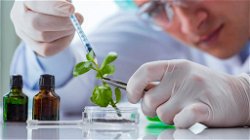The Successful Application of Technology in Agriculture
Alvish Asher
. 1 min read
Over the course of time, there has been a significant amount of progress made in the field of agriculture. Even though many time-honored practices and tools are still in use, the agricultural industry is being revolutionized by ever-evolving technologies that are more productive, cost-saving, and forward-thinking. These developments are opening up previously unimaginable doors. With the introduction of cam chat, new doors have opened, enabling efficient resource management and transforming crop cultivation.

The following is a List of the top Five Technological Advancements
What does it mean to practice precision agriculture?
Improved crop quality and profitability can be achieved through the practice of precision farming, which makes use of cutting-edge technologies such as satellite imagery and field mapping. Moreover, it optimizes the use of traditional resources. This agricultural management system therefore contributes to the development of sustainable agriculture, which allows for the solution of both economic and ecological problems.
Robotics and Computers in Industry
Even though many businesses hire hundreds of production workers for up to three shifts, in order to keep the plant operational for the greatest number of hours possible, the plant must still be shut down for holidays and maintenance. The goal of the company can be accomplished with the help of industrial automation because it enables the company to keep a manufacturing plant operational around the clock.
The incorporation of embedded computing technology
The ingenious ICT technique presents a covert system that manages facilities in areas with a scarcity of water by making use of minimum value soil wetness sensing element and temperature sensing element. The sensor, which measures the difference in the soil's resistance to change based on the amount of moisture present between two points.
Remote Sensing and the Ways
Images acquired through remote sensing can be analyzed in order to detect nutrient deficiencies, diseases, insufficient or excessive water levels, weed infestations, insect damage, hail damage, wind damage, herbicide damage, and plant populations. The data gathered from remote sensing can serve as a foundation for developing base maps for variable rate application of pesticides and fertilizers.
What exactly is meant by the term "genetic modification of crops" (GM)?
Insertion of DNA into the genome of an organism is the technological basis of genetic modification (GM). In order to create a genetically modified plant, new DNA must be introduced into plant cells. In most cases, the cells are then grown into plants through a process called tissue culture, where they continue to develop. The new DNA will be passed down through these plants' offspring, which is the seeds.
More Stories from
Unveiling India's Volcanic Secrets: A Geological Overview
Explore India's unique volcanic history and the enduring forces of nature that continue to captivate scientists and adventurers alike.
Mitigating Earthquake Impact: Strategies for Resilient Communities
This article provides an insightful overview of earthquakes, their causes, and effective strategies for mitigating their impact.
Zero-Waste Living: Practical Tips for Reducing Environmental Impact
Discover the power of zero-waste living as this article offers practical tips and actionable advice for reducing your environmental impact.
Eco-Friendly Practices: How Individuals and Businesses Can Make a Difference
Discover the Power of Eco-Friendly Practices: Learn how individuals and businesses can contribute to a greener world by adopting sustainable measures.
Biotechnology and the Future of Medicine: Advancements and Ethical Concerns
This article explores precision medicine's personalized treatments, the promise and ethical challenges of gene editing, the potential of artificial intelligence in healthcare, and the future of organ transplantation.










.png?width=40&aspect_ratio=1:1)


.png?width=40&aspect_ratio=1:1)